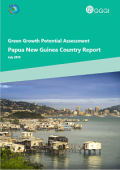This case study examines the cost of the impacts of climate change on Jamaica. The analysis reveals that the current cumulative loss of GDP due to damage associated with natural disasters was estimated to be in the order of $120 billion (7 percent of GDP). When this is coupled with potential climate change induced impacts, such as an increase in the number of extreme hurricanes, the figure is even more worrisome as it is likely to rise.
Climate Change Impacts on Coastal Transport Infrastructure in the Caribbean - Saint Lucia Case Study
This case study presents the assessment of the criticality of Saint Lucia’s major transportation assets (airports and seaports) and their potential vulnerabilities to climate variability and change.

This paper discusses agriculture in Uganda and suggests that climate change could decrease output per adult by 20% by 2100, due to changes to food consumption and labor supply.
This is a roadmap to sustainable accommodation and MICE sectors in the Philippines, via resource-efficient and low-carbon development. Its vision is to enhance a globally recognized tourism destination that showcases and protects the natural beauty of the Philippines, the hospitality of its people and its cultural identity.
This paper presents an ex-ante cost-benefit analysis of large-scale rangeland restoration through the Hima system within the Zarqa River Basin, drawing on experience from a pilot initiative by the International Union for Conservation of Nature (IUCN) and the Jordanian Ministry of Agriculture since 2010. The ecosystem services that arise from rangeland restoration are valued using a combination of stated preference, avoided costs, replacement cost, and market prices approaches.
This case study provides an updated overview of the European electricity sector transition, focusing on key topics like the growth in renewables, conventional power generation, electricity consumption, and CO₂ emissions. The case study also provides an overview of 2018 electricity consumption, generation and emissions by country with downloadable data for emissions by country to enable others to also perform up-to-date analysis.
These case studies demonstrate how corporate buyers have effectively embedded sustainability in their procurement processes to improve resource efficiency and reduce GHG emissions.
This case study of Myanmar assesses where and how ecosystems provide key benefits to the country’s people and infrastructure. It models the supply of and demand for sediment retention, dry-season baseflows, flood risk reduction and coastal storm protection from multiple beneficiaries.

The publication Climate Smart Agriculture: Successes from Africa

This report, Green Growth Potential Assessment: Papua New Guinea country report presents the findings of the Green Growth Potential Assessment (GGPA) of Papua New Guinea and details the recommendations, each supported by a solid rationale and directly support achieving the goals set out in Papua New Guinea’s Vision 2050.
